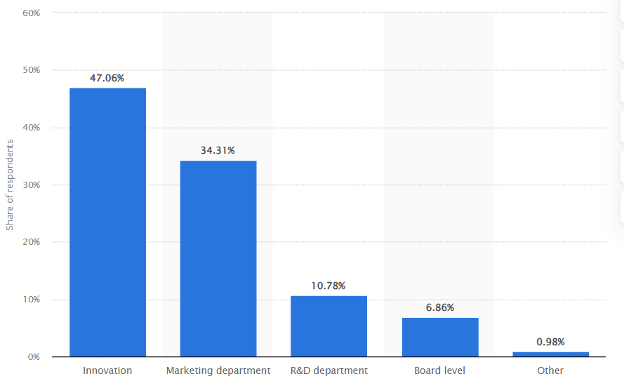The corporate landscape is on the brink of a seismic shift, and at the heart of this transformation lies the emergence of the metaverse. As CEOs go through the complexities of the modern business environment, they understand that strategic leveraging of the metaverse is not just an option anymore – it is a necessity.
Business departments across the globe have been actively showcasing interest in the metaverse since 2022. 47.06%, for instance, suggested that they’re going to empower innovation while reducing risks via the metaverse. 34.31% suggested that they’re going to use it for marketing.

In this article, we will look into the intricacies of the metaverse’s evolution, its potential impact on industries, and the strategic considerations imperative for CEOs seeking to harness its potential.
The Metaverse Evolution: A Three-Phase Journey
The metaverse’s trajectory is characterized by three interconnected phases: emerging, advanced, and mature. Distinct shifts in technology, market dynamics, and the products/services defining the metaverse experience distinguish each phase.
While the metaverse’s full maturity is not anticipated before 2030, the strategic advantage lies in evaluating opportunities for interaction capabilities, content, and infrastructure now.
The metaverse is a digital, immersive, and interconnected virtual space that goes beyond traditional online experiences. It integrates augmented reality (AR), virtual reality (VR), and other technologies to create a shared, interactive environment where users can engage with digital content and each other in real-time.
Metaverse’s Connection to Organizational Success
The metaverse is increasingly relevant to organizational success as it offers new avenues for collaboration, innovation, and customer engagement. Businesses can utilize the metaverse to enhance communication, conduct virtual meetings, and create immersive experiences for customers. Organizations that strategically leverage the metaverse can gain a competitive edge by tapping into novel ways of reaching and interacting with their target audience.
CEOs play a critical role in navigating their organizations through the metaverse landscape. They need to:
- Understand the Landscape: CEOs must comprehend the evolving metaverse ecosystem, identifying opportunities and risks relevant to their industry. Furthermore, CEOs need to help their company culture evolve with respect to this new landscape.
- Strategic Integration: Integrate metaverse technologies strategically to enhance internal collaboration, customer engagement, and overall operational efficiency.
- Innovation Leadership: Encourage and drive innovation within the organization by exploring metaverse-inspired solutions that align with business objectives.
- Ecosystem Engagement: CEOs should actively engage with industry standards, collaborate with content creators, and foster partnerships that enhance the organization’s metaverse presence.
- Business Model Adaptation: Assess and adapt business models to align with metaverse trends, including potential shifts in customer behavior, revenue streams, and market dynamics.
Strategic Imperatives for CEOs in the Metaverse Landscape
For CEOs to adopt the metaverse, they need to have a strategic roadmap in light of their organization. It’s not just about the opportunities that it presents, but also the risks therein. Furthermore, the operator mindset needs to be adapted to this evolution, too – something that CEOs must play a critical part in.
Here are the imperatives to guide your organization through this transformative journey:
- Build Innovative Solutions:
- Foster a continuous pipeline of innovation based on emergent technologies like spatial computing.
- The metaverse’s power lies not in a single “killer app” but in the combination of interactive experiences.
- Think beyond the conventional to build a metaverse-ready product ecosystem.
- Identify Opportunities:
- Evaluate current high-value use cases, such as gaming, navigation apps, VR, and AR experiences, concerning your product or service.
- Aligning with current market needs positions your organization strategically within the evolving metaverse landscape.
- Extend Collaboration:
- Proactively engage with or create an ecosystem of standards, content, and service delivery partners.
- Collaboration between c-suite executives is key to crafting a cohesive metaverse experience. Anticipate the developing aspects of the metaverse and act in concert with industry players.
- Prepare for Business Model Transformation:
- Assess trends including superapps, pricing and payment methods, and API integration/monetization.
- Understand how these trends will reshape the business landscape as the metaverse evolves.
- Be prepared to adapt and transform your business model accordingly.
Evolution of Products & Services With The Metaverse
The metaverse’s evolution unfolds through three distinct phases, each offering unique opportunities and challenges. CEOs must understand these phases and the association with different market trends throughout the year.
- Emerging Phase (Until 2024):
- Opportunities in this phase are limited, with a focus on exploring high-value use cases inspired by current applications.
- Technologies not explicitly meant for creating the metaverse will contribute to the combinatorial trend, offering indirect opportunities.
- The interface layer, with a relatively lower entry barrier, will witness heightened activity.
- Advanced Phase (2024 – 2027):
- Direct opportunities for the metaverse will increase, particularly in the content layer, encompassing data, information, and the foundation of the metaverse
- Tools and technologies facilitating the mapping and understanding of the physical environment will gain prominence.
- Democratizing the creation of virtual environments and analyzing relationships between physical and digital elements will be key focus areas.
- Mature Phase (From 2028 Onward):
- The metaverse’s vision becomes clearer, with opportunities in the infrastructure layer taking center stage.
- Advances in technologies like 5G, AR (artificial reality) tech, and digital currencies (especially blockchain-based ones) will reinforce the metaverse’s functionalities.
- Significant opportunities will emerge as organizations and users gain a deeper understanding of the metaverse’s aspects and functionalities.
A prime example of this is the dependence of metaverse on integration of AI and ML models. The reliance of AI allows organizations to transform their operations toward improved efficiency in the emerging phase. However, CEOs must consider the ethical and privacy issues associated with AI use as well as we move towards the Advanced Phase.
Next Steps for CEOs For Metaverse Exploration
As CEOs embark on the metaverse journey, a comprehensive approach is essential. Here are the next steps for CEOs aiming to harness the metaverse’s potential:
- Evaluate the Growth Spectrum:
- Strategic Entry: Assess the metaverse evolution spectrum to strategically decide when and how to enter the market.
- Understanding the growth trajectory is fundamental to gaining a competitive edge.
- Explore Interaction, Content, and Infrastructure:
- Comprehensive Evaluation: Evaluate opportunities across interaction, content, and infrastructure layers.
- A balanced approach ensures a comprehensive metaverse strategy that considers the multifaceted nature of this digital step toward the future.
- Features and Functionalities:
- Technology Enablers: Explore the features and functionalities enabled by technologies in market subsegments.
- Evaluate the significance of devices and browsers within the interaction layer, cryptocurrencies and graphics tools in the content domain, and the role of edge computing and P2P networks in shaping the foundational infrastructure of the metaverse landscape
Conclusion: Pioneering the Metaverse Frontier
The metaverse is not a distant vision but a dynamic landscape evolving through distinct phases. CEOs must adopt a proactive stance now to position their organizations not only to survive but to thrive in this transformative digital world.
As the metaverse moves into its second phase, it calls out businesses and their strategic leaders to be pioneers in a new era of business growth, collaboration, and customer engagement. The metaverse is unveiled, and the time for CEOs to strategically lead their organizations through this transformative journey is now.
Learn about other 2024 trends in – 2024 Emerging Trends: Quantum Computing Strategies for CEO.


0 Comments